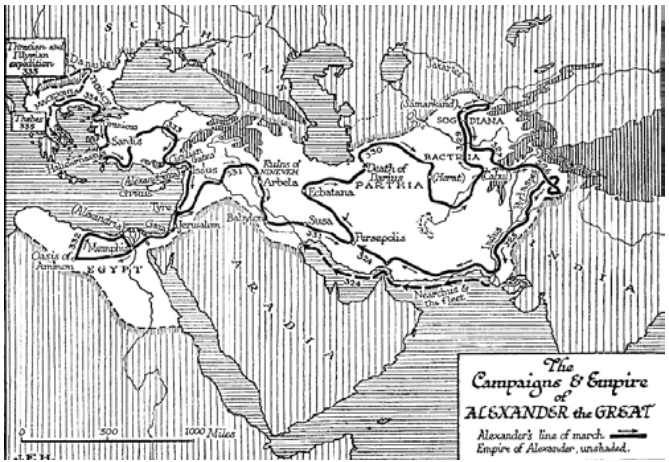By: Bojana Jovanovska*
The Silk Road represents a rich and long history that dates back to the era of Alexander the Great’s regime and continues to the present day. To understand the importance of Macedonia within this historical context and how it came to play a particular role, we must present the situation starting from those ancient times. My focus will be on the economic dimensions and the potential benefits that have accrued to Macedonia from this journey.
Alexander the Great: Transforming regional economies alongside the Silk Road route
As one of the most influential historical figures, Alexander the Great was not only a good leader but also an emperor that put a lot of effort into improving the well-being of his citizens. With his territorial expansion not only in Europe, but also in Africa and Asia, Alexander the Great made a movement which proved to the world how a big kingdom can have economic benefits from establishing, back then, new trading routes and adding economic priorities. Obviously, the new lands conquered by Alexander required expansion with new economic ways, so that process led to a new chapter, the chapter of establishing new economic policies with a specific focus on the food production and food availability around the areas. As a result of this the urban centers were founded. These urban centers were mainly used as hubs for commerce and attracting new merchants. A major characteristic that helped out in supporting the idea of a new economic pathway (the Silk Road) was the structure of the Hellenic economy back then. It was the fact that during that era the spread of the Greek culture across the lands was significant, with a goal to spread local traditions or customs in order to create a rich civilization. Furthermore advanced research was happening in the field of astronomy, philosophy, science and mathematics. Under these circumstances a quest for new economic cooperation was aroused. At this point the trading connection between the West and the East was necessary. That’s when the Silk Road got its importance. It became a special route for trades between the Mediterranean, China, Persia and India; however it also became a path for cultural exchanges and exchanges of ideas.
Now what kind of an impact did it have on the trade? Firstly, goods were traded. Here we are talking about variety of goods such as, silk from China, spices from India, glassware and wine from the Mediterranean, horses from Central Asia and many more. This is one aspect proving how the Silk Road managed to bring some benefits for the economies in ancient times; another one is the cultural exchange. The cultural exchange was a delivery route for ideas and cultures. As an illustration it also enabled the spreading of Buddhism from India to China, helped the introduction of new technologies, methods and resources between the East and the West.
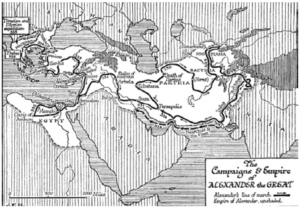
Map of Alexander the Great’s conquests. Source: Florida Center for Instructional Technology, University of South Florida, from H. G. Wells, the Outline of History (New York, NY: The Macmillan Company, 1921)
All things considered, Alexander the Great helped to shape the future of the Silk Road by his policies that required establishing agreements in the regions that were under his reign and by recognizing the importance of the new route, a road that can bring prosperity for many nations and help out reentering into new ages of cooperation among the civilizations back in that period of time.
From Ancient trade routes to the new Belt and Road: Macedonia’s new role in the BRI
So, how does this story align with today? Since many readers might not be familiar with Macedonia, I would like to introduce some crucial details about it, including its location and other general information about the country.
As a beginning we are talking about a small country, a country that is located in the heart of the Balkan Peninsula in the European continent. Previously part of the Socialist Federal Republic of Yugoslavia, North Macedonia became independent in 1991 and transitioned to a democratic system. Once called the Republic of Macedonia, it was known as FYROM due to a dispute with Greece. In 2019, after an agreement with Greece, it renamed itself to the Republic of North Macedonia, enabling its NATO membership and progress towards EU accession. Today, North Macedonia is a member of the UN, NATO, and the Council of Europe, and is a candidate for EU membership.
In terms of the economy, Macedonia is classified as an upper-middle- income economy by the World Bank. Macedonia is also rich in a variety of natural resources, including minerals like iron ore, silver, gold, copper, manganese, metal, etc. The country also has significant presence of flora and fauna, mountains, forests, and lakes. The main economic activities that are developed in Macedonia are agriculture, tourism, construction, mining, energy and fuel production, manufacturing, tobacco, chemical and pharmaceutical manufacturing, and production of automotive components.
Macedonia and China established ambassadorial-level diplomatic relations on October 12, 1993, since then the relations between the two countries are described as fair and with mutual respect. As a result a major part of the cooperation between China and Macedonia is based on the trading aspect. Since 2023, China became the fifth largest trading partner for Macedonia after Germany, the UK, Serbia and Greece. During 2018, Macedonia and China achieved the highest annual mutual trading growth rate of 29% and in 2019, it was noted that China was the third import and export partner destination for Macedonia, after the EU and Serbia.
Macedonia’s main export goods to China are ferroalloys, marble, travertine and alabaster. On the side of imports from China to Macedonia, the largest contributors are telecommunication equipment, including telephones for cellular networks, television receivers, and air conditioning devices.
Graph 1. Trading intensity results for Macedonia with China
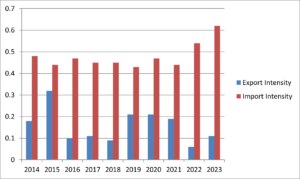
Source: ANALYSIS OF THE TRADE RELATIONS BETWEEN THE REPUBLIC OF NORTH MACEDONIA AND CHINA, Prof. Kostadinka Panova & Prof. Emilija Miteva-Kacarski.
If we look at the analyzed period, we can notice that even if the rate of intensity of the import and export is below 1, still the bilateral trade shows an upward trend. In 2019, exports witnessed the highest annual rate of 154, 4% and made a space for more future upcoming trading deals.
Macedonia in the Belt and Road
Since 2013, Macedonia officially joined the Belt and Road Initiative (BRI). During the period from 2012-2015, it was considered the “golden age” of the Sino-Macedonian relations, with joint projects in infrastructure, Macedonia joining the 16+1 initiative (now the China-CEEC Cooperation). Besides that, the two countries started entering a new cultural cooperation momentum with the opening of the Confucius Institute under the most prestigious university in Macedonia, the Ss. Cyril and Methodius University in Skopje, the capital city of the country. In 2013, then Macedonian President Gjorge Ivanov met with Chinese President Xi Jinping in Beijing, reaching an agreement on deeper cooperation covering trade, infrastructure, and foreign direct investments (FDIs). Today, companies like Huawei, Xiaomi, Sinohydro, and China Machinery Industry Group operate in Macedonia.
On the other hand, a lot of people are asking themselves why Macedonia, as a small country, is an important partner for China? Well to answer this, we need to look at the geographical location that the country is positioned in. The country plays an important role into entering not only the EU market, but also another major market within the European continent, that is the Balkan market. It is a crucial country that is part of the so-called “Balkan Belt and Road”. China plays a significant role in boosting the Macedonian economy, not just in trade but also in the infrastructure. The Macedonian government’s top priority is to develop a nation that can thrive in the 21st century, especially in two crucial areas: “Corridor 8” and “Corridor 10” corridors. Why these two corridors are that important? Firstly, Corridor VIII is a combined road and rail transport corridor traversing Albania, Macedonia, and Bulgaria. It links the Bulgarian port of Varna on the Black Sea to the port of Durrës in the Adriatic Sea. This chain further extends to Italy, the only EU member within this corridor. Its purpose is to ease trade and transportation across the Balkans, bridging the Adriatic and the Black Sea. On the other hand, Corridor X is part of the Trans-European Transport Network (TEN-T). It stretches from the border with Serbia to the border with Greece and connects multiple countries such as Austria, Slovenia, Croatia, Serbia, and Greece. It’s highly important for assisting in transit and trade from the Balkan region to Central Europe and beyond. Both of them are viewed as important infrastructural projects and investments for Europe and for Macedonia. These corridors will enable Macedonia as a landlocked country to have an access to seas and ports around the European continent, from this point of view China also views Macedonia as a potential economic partner because of these two important lines. Through these corridors, especially through corridor X, the Chinese goods could be delivered to Central Europe or any other European country in a relatively short period of time.
Map, Corridor VIII
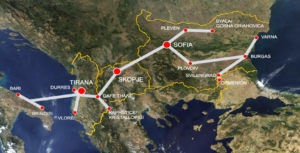
Source: European Commission
Map, Corridor X
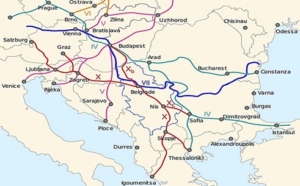
Source: European Commission
Today Macedonia, as a participating country in the BRI, some important infrastructural projects took place in, such as the FD Expressway section. On July 18, 2023, POWERCHINA completed the right tunnel of the Farish-Drenovo Expressway Section, part of the Gradsko-Prilep Expressway which is aiming to improve central North Macedonia’s transportation. On January 14, 2025, the rest of the FD Expressway project by China Power Construction Corporation opened to traffic. Another project is the 13.75 – km Krupiste-Kocani Expressway, located about 107 km northeast of Skopje, is the second phase of the Štip-Kočani infrastructure project. It is part of North Macedonia’s A3 Highway and Pan – European Corridor 8. Linking Eastern North Macedonia to the China – Europe Land – Sea Express Route under the BRI. It has been operational since 2022. One project that holds a significant importance is the MS Expressway. North Macedonia’s National Highway Bureau announced the official opening of the Miladinovci-Stip (MS) Expressway on June 5, 2019. Constructed by POWERCHINA’s subsidiary Sinohydro Engineering, this vital infrastructure project now enables two-way traffic, significantly reducing travel time between Stip and Skopje from 90 minutes to just 30 minutes. It is a flagship BRI project in the Balkans, which the MS Expressway represents the first major infrastructure development under China-Central and Eastern European (CEE) cooperation. The 57 km Kichevo-Ohrid highway stands as one of North Macedonia’s most ambitious transportation projects in recent years. It is designed to enable connectivity between Ohrid—the country’s most important tourism oriented city —and other regions, the highway’s construction began in 2013 and the project is being executed by the Chinese enterprise Sinohydro.
From the cultural cooperation point of view, the Confucius Institute as part of the BRI journey in Macedonia is considered as a key institution for a stable cooperation between the two countries. It was opened in 2013, with an agreement that involved local and Chinese institutions within the Belt and Road framework. Today, located in the university’s public library, it functions as a hub for Chinese language education and cultural exchange.
In conclusion, Macedonia is involved in the Belt and Road Initiative, with China supporting its development across various sectors. Tourism and trade can be considered as present opportunities for further cooperation, and Macedonia, along with other countries, can play a role in facilitating the transfer of Chinese goods to Central Europe, putting more efforts on deeper infrastructural collaboration and building railways. The Confucius Institute in Macedonia not only promotes the Chinese culture and the language but also aids in economic and trading prospects.
* Bojana Jovanovska is a master and language student at University of Ss. Cyril and Methodius in Skopie, North Macedonia, and Xi’an Jiaotong University, China.

